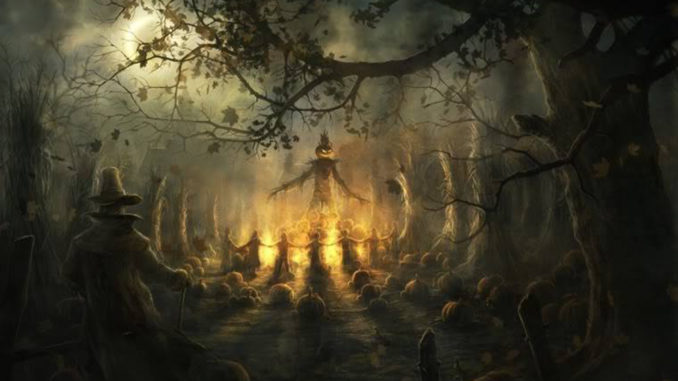
Halloween Celebrations: A Historical View
Halloween. Many of us celebrate it but know not its history. Those of us in the paranormal field know that legend holds that the veil is thinnest on Halloween and it is a great night to commune with the spirit world. But why? Where does this belief come from?
We dug through my books and found a great article on Halloween from Rosemary Ellen Guiley that we have posted verbatim in order to educate you a little more on the topic of Halloween, including its history and customs from ancient times to this very day.
Many of you know of the late Rosemary Ellen Guiley. She documented so much of this paranormal world in digestible forms. The following excerpt on All Hallow’s Eve is taken from her wonderful work, The Encyclopedia of Ghosts and Spirits, 2nd edition.
All Hallow’s Eve (Halloween)
A pagan festival of the dead, which has survived to the present in popular culture as Halloween, a night of trick-or-treating by children and others dressed in costumes of fantasy and the supernatural. All Hallow’s Eve is observed the night of October 31, followed on November 1 by All Hallow’s Day, also called All Hallowmas, All Saints and All Saints’ Day, and November 2 by All Souls’ Day.
The ancient Celts celebrated the new year at the start of winter, around November 1. This most sacred of all Celtic festivals was called Samhain (pronounced Sow’an), which means “end of summer.” In Ireland the festival was known as Samhain, or La Samon, for the Feast of the Sun. In Scotland, the celebration was known as Hallowe’en.
Samhain marked the third and final harvest and the storage of provisions for the winter. It was a solar festival consisting of sacred fire and fire rituals. It was dedicated to the Lord of the Dead. The Celts believed that on the eve of Samhain, the dead rose out of their graves to wander freely about the earth and make trouble by harming crops and causing domestic disturbances. The veil between the worlds of the living and the dead was believed to be at its thinnest point in the year at Samhain, making communication between the living and the dead much easier.
During the darkest hours of the night, the Lord of the Dead also was believed to call up all the lost souls for resentencing. Condemned souls were sentenced to spend 12 months in the afterlife in an animal form, while good souls received another 12 months of death, albeit in the form of human beings. Living persons held a Samhain vigil during the dark hours to pray for the lost souls.
Some of the customs practiced by the Celts for Samhain remain in various forms and are similar to other Day of the Dead practices found throughout the world.
It was customary for the Celts to make offerings of food and wine to the Lord of the Dead so that he would be more agreeable in his sentencing of the lost souls. Offerings also were set out for the returning dead themselves so that they could refresh themselves and perhaps be less inclined to cause mischief.
The Celts dressed themselves in disguises so as to fool the spirits into passing them by. Masked villagers led parades in an effort to entice spirits out-of-town.
Another Celtic ritual at Samhain was the lighting of huge bonfires as tribute to the waning sun god in an effort to rekindle his diminishing energy in the face of winter. The Celts burned alive horses, which they considered sacred to the sun god. In the Middle Ages, cats were burned alive in wicker cages as part of All Hallow’s observances.
The Romans celebrated several festivals that influenced the evolution of Halloween. Lemuria, practiced in early Rome and influenced by Greek custom, was a three day affair that took place in May. Its purpose was to the appease the lemures, who were evil ghosts or the ghosts of people who had died without leaving behind a surviving family. Another festival, Paternalia, observed in February, was a private affair in which families honored their own dead with gifts, food and flowers placed on their tombs. Paternalia was followed by the Feralia, a public festival intended to give rest and peace to the departed. Participants made sacrifices in honor of the dead, offered prayers for them and made oblations to them. The festival was celebrated February 21, the end of the Roman year.
At the same time of year that the Celts were celebrating Samhain, the Romans celebrated the festival of Pomona, the goddess of orchards and the harvest. Apples and nuts were among the special food used, and these retained a place in surviving Halloween festivities.

T-Shirts, Mugs and More!
We now have t-shirts, tarot decks, ESP cards, coffee mugs, face masks, and much more merchandise available for purchase. Every dollar spent helps fund Paranormal Study!
When the Christian Church set out to convert followers of pagan religions, church leaders astutely saw that they would have an easier time if they incorporated existing holy days and rites into their own. Worship of pagan deities was translated into the veneration of the Christian saints. In the 8th century, Pope Boniface IV introduced All Saints’ Day to replace the pagan festival of the dead on May 13, 610, when he dedicated the Pantheon in Rome to St. Mary and martyred Christians. Later, Gregory III reestablished the festival to honor the saints of St. Peter’s Church and changed the date from May 13 to November 1 to coincide with pagan festivals. (Presently the Greek Orthodox Church still observes it on the first Sunday after Pentecost.) In 834, Pope Gregory IV made the festival official, to be observed by all churches.
Instead of sacrifices, the Church promoted honoring the dead with prayers. Food and wine offerings were replaced with soul cakes, little square buns decorated with currants. The cakes were given away to the village poor, who in turn would pray for the dead. “Soulers” would walk about begging for cakes. People who feared the spirits of the dead – or feared for the them – were encouraged to give generously. In Ireland, peasants went door to door to collect money, breadcake, cheese, eggs, butter, nuts, apples, etc., in preparation for the festival of St. Columb Kill. The Christian Church also allowed masquerading but emphasized that it was to honor dead saints and not to frighten off spirits.
Over time, these collection practices transformed into a popular practice for young men and boys, who went from home to home singing “souling songs” in exchange for ale and food. This is turn evolved into contemporary trick-or-treating by youngsters.
By the 10th century, November 2 has become All Souls’ Day, the feast day for the dead. The holiday was approved by Pope Sylvester II around 1000 and became established throughout Europe from the 11th through 14th centuries.
The Reformation had a drastic effect on All Saints’ Day and All Souls’ Day. In 1517, Martin Luther deliberately picked October 31 as the day to nail his reformations to the door of the castle church at Wittenberg, because he knew that the townspeople would be attending services that night. The Protestant movement dropped the observances of saints’ days, and with that went the rites performed on the eve of All Saints’ Day as well.
All Hallow’s Eve practices continued on in pockets, especially in Celtic areas such as the British Isles, surviving as folk rites, with feasts, fires, games and pranks. As time went on the ranks of the dead were joined by witches, fairies, goblins and spirits of local lore, who were said to come out in force on this particular night. The wild hunt, a furious pack of ghosts of the restless dead, led by spectral hounds and pagan goddesses-turned-witches, screaming through the sky, took place on All Hallow’s Eve.
In England, Guy Fawkes Day, celebrated on November 5, became the festival that absorbed the primary characteristics of Samhain and All Saints’ Day. (Guy Fawkes was a Catholic revolutionary who was executed for his attempt to blow up the Protestant-sympathetic House of Lords on November 5, 1605.) Even today, Halloween is a minor affair in England, with feasting, fireworks, games and bonfires taking place on Guy Fawkes Day instead.
In colonial America, Halloween celebrations were scattered. Practices varied widely depending upon the dominance of a particular ethnic group. Areas heavily settled by the English – such as Massachusetts, a stronghold of English Calvinists – paid scant attention to Halloween, while areas predominated by Scots or Irish gave Halloween more due.
It was not until the potato famines of the 1820s and 1840s drove thousands of poverty stricken Irish to the United States that Halloween became more established in American folklore. Hearth fires replaced the Celtic bonfires; parlor divination games replaced oracular rites; harvest feasts replaced the feasts for the dead; and young people played tricks on neighbors. The customs of wearing masked costumes and begging for food also continued. Parties, also part of the annual harvest rites, included games, dancing and the telling of ghost stories.
The Irish had a Halloween custom of carrying lanterns made out of hallowed-out turnips or beets, called jack o’ lanterns or jacky lanterns, which were used to scare away spirits in the night. Immigrants to America substituted pumpkins.
Halloween customs followed immigrants as they moved across America. In the West and Southwest, the customs were influenced by the Mexican Day of the Dead rites, which conforms to Catholic dates of the eve of October 31 to November 2.
During Victorian times in America, Halloween enjoyed a renaissance as a genteel party. The pagan customs had a particular appeal to Victorian society, which watered them down to prim social rites. Halloween became a festive night for young people and played an important matchmaking role. Pageants with costumes were popular.
During the early years of the 20th century, Halloween in the United States was largely a community affair, a time for large social gatherings. The festival was subdued or canceled during World War II, and emerged in the post-war, baby-boom years as a big event for youngsters. Door-to-door trick-or-treating for candy was favored over community parties. In the 1970’s and 1980’s, poisoned candy became a concern, and community parties enjoyed a comeback.
The original purpose of All Hallow’s Eve, or Samhain, as a festival for the dead has nearly been forgotten, save among contemporary Wiccans and Pagans. These religious groups observe Samhain as one of their most important holy days, or sabbas – a time for feasting and merriment, but also a time for solemn religious observances. Wiccans and Pagans have attempted to re-create early pagan rites with the exception of animal sacrifices, which are forbidden. The dead are honored. Samhain is considered a good time for communing with the spirits and, as the start of the new year, a good time for beginnings and fresh starts.
If you found the content in this article to be of any value to your paranormal studies, please let us know in the comments below. Feel free to share this article with your friends as well because if you found it interesting, they might too.
Do You Want To Know More?
Our content creators also have podcasts that go much deeper into paranormal topics.
Tim Woolworth’s Walk in the Shadows, an episodic masterclass that consists of a deep dive into all things Fortean, paranormal and supernatural.
Rick Hale teams up with Stephen Lancaster in The Shadow Initiative where they explore various paranormal topics and discuss current paranormal news.
Please check these shows out and visit Paranormal Study social media to keep up to date on articles and all the things our authors are doing.

Be the first to comment